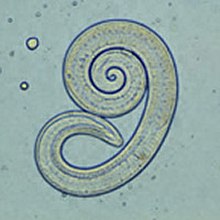Trichina
| Trichinella | |
|---|---|
 |
|
| Scientific classification | |
| Kingdom: | Animalia |
| Phylum: | Nematoda |
| Class: | Adenophorea |
| Order: | Trichocephalida |
| Family: | Trichinellidae |
| Genus: |
Trichinella Railliet, 1895 |
| Species | |
|
Trichinella britovi |
|
Trichinella britovi
Trichinella murrelli
Trichinella nativa
Trichinella nelsoni
Trichinella papuae
Trichinella pseudospiralis
Trichinella spiralis
Trichinella zimbabwensis
Trichinella is the genus of parasitic roundworms of the phylum Nematoda that cause trichinosis (also known as trichinellosis). Members of this genus are often called trichinella or trichina worms. A characteristic of Nematoda is the one-way digestive tract, with a pseudocoelom (body cavity made up of only an ectoderm and endoderm).
The genus was first recognised in a larval form in 1835. The L1 larvae live in a modified skeletal muscle cell. The adult worms occupy a membrane-bound portion of columnar epithelium, living as intramulticellular parasites. Infections with this genus have been reported from more than 150 different naturally or experimentally infected hosts. It has been shown to have a worldwide distribution in domestic and/or sylvatic animals.
Trichinella is known as the smallest human nematode parasite, yet it is also the largest of all intracellular parasites.
Oral ingestion of larvae-contaminated tissue is the usual route of infection, but congenital and mammary transmission can occur in rats.
Eight species are currently recognized. Four additional genotypes require adequate description before they can be recognized as valid species.
Two main clades are recognized in the genus: one group (T. britovi, T. murrelli, T. nativa, T. nelsoni, T. spiralis) that encapsulates in host muscle tissue and a second (T. papuae, T. pseudospiralis, T. zimbabwensis) that does not.
The nonencapsulated group infects saurians, crocodilians, and other nonavian archosaurs (T. papuae, T. zimbabwensis) and birds (T. pseudospiralis). The encapsulated group infects synapsid and mammalian hosts. T. spiralis and T. nelsoni appear to be basal in the encapsulated group and T. murrelli and T. nativa the most recently evolved.
Trichinella species can infect swine, horses, wild animals (foxes, wolves, bears, skunk, raccoons, rats, and other small mammals), and humans.
...
Wikipedia
